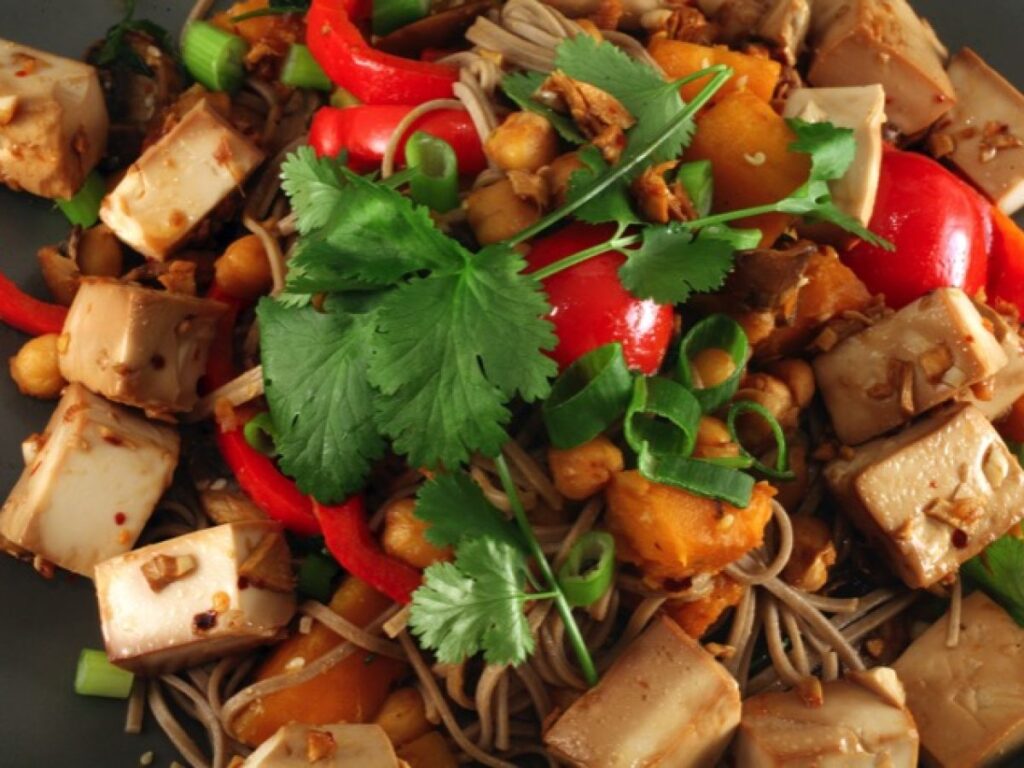Introduction
In the world of plant-based cuisine, few dishes strike the perfect balance between nutrition, texture, and umami quite like Vegan Seaweed and Tofu Stir-Fry. This vibrant, quick-cooking meal combines the mild, absorbent nature of tofu with the briny, mineral-rich depth of seaweed, all stir-fried with crisp vegetables and aromatic seasonings for a symphony of flavors: savory soy notes, subtle oceanic hints, and a touch of heat or sweetness to tie it together. Whether you’re a seasoned vegan seeking new ways to incorporate sea vegetables or a newcomer exploring meat-free meals, this stir-fry is an accessible gateway to healthful, satisfying eating—ready in under 40 minutes and bursting with vitamins, iodine, and protein.
This comprehensive 3,000+ word guide demystifies Vegan Seaweed and Tofu Stir-Fry, equipping you with everything needed to create a restaurant-quality version at home. From its ancient roots in Asian traditions to a step-by-step recipe inspired by modern adaptations, our 7 insider secrets for perfection, common mistakes to avoid, creative variations, serving suggestions, nutritional insights, and handy FAQs, this article is your ultimate resource. We’ll integrate internal links to our site’s content, such as our vegan appetizer ideas, and external resources for further exploration. Drawing from authentic recipes, the key lies in rehydrating seaweed properly, pressing tofu for crispiness, and balancing flavors with miso or soy for that irresistible umami.

Why embrace this dish? Seaweed and tofu are vegan superstars: low-calorie, high in essential minerals like iodine (vital for thyroid health), and versatile for gluten-free or low-carb tweaks. Homemade versions outshine takeout by avoiding excess oils and preservatives, costing under $10 for four servings versus $15+ from delivery. As veganism surges—global plant-based food sales hit $29.4 billion in 2023—this stir-fry aligns with trends toward sustainable, ocean-sourced ingredients. Ready to dive into this nutritious ocean of flavor? Let’s stir things up!
The Ancient Origins: Seaweed and Tofu in Vegan Cuisine
The story of Vegan Seaweed and Tofu Stir-Fry is woven from two ancient staples that have sustained plant-based diets for millennia, evolving from humble Asian origins to global vegan favorites. Tofu, or “doufu” in Chinese, traces back to the Han Dynasty (206 BCE–220 CE), likely invented in ancient China when a cook accidentally curdled soy milk with nigari—a coagulant derived from seaweed, marking an early intersection of these ingredients.
Seaweed’s history is even older, with evidence of consumption dating to prehistoric Europe (5,000–8,000 years ago), where dental plaque from ancient skeletons reveals red and brown algae as dietary staples for coastal communities. In Asia, seaweed (known as “hai zao” in Chinese) has been harvested since at least 600 BCE, prized in Traditional Chinese Medicine for detoxifying properties and iodine content. Japanese records from the Nara period (710–794 CE) document nori, wakame, and kombu in vegan diets, often paired with tofu in shojin ryori—Buddhist vegetarian meals emphasizing harmony and minimalism. By the Tang Dynasty (618–907 CE), seaweed was a common thickener and flavor enhancer in stir-fries, symbolizing longevity in folklore.
The modern stir-fry fusion emerged in the 20th century amid Chinese diaspora and Western vegan movements. In the U.S., tofu gained traction during the 1960s counterculture, popularized by books like “Diet for a Small Planet” (1971), while seaweed entered via macrobiotic diets promoted by Michio Kushi in the 1970s.
Ingredients for Vegan Seaweed and Tofu Stir-Fry
For 4 servings, gather these wholesome staples. We draw from arame-based recipes for its mild flavor, but wakame or nori work too.
- 1 package (14-16 oz) firm tofu, pressed and cubed
- 1/4 cup dried arame seaweed (or wakame)
- 2 large carrots, sliced diagonally
- 1 red bell pepper, diced
- 2 baby bok choy, sliced
- 1 package (3.5 oz) mushrooms (shiitake or beech)
- 3 green onions, sliced
- 1 shallot, chopped
- 2 garlic cloves, minced
- 1 tsp grated fresh ginger
- 2 tbsp olive oil or sesame oil
- 2 tbsp shoyu or low-sodium soy sauce
- 2 tbsp mirin (rice wine)
- 1 cup vegetable broth
- 1 tbsp white miso paste
- 1/4 tsp red pepper flakes (optional)
- 2 tbsp chopped cilantro (for garnish)
- Optional: 1 cup cooked basmati rice or noodles for serving
That’s the essentials! Arame provides iodine and minerals; tofu adds protein (about 20g per serving). Tools: Wok, strainer, cutting board. Source sustainably with our vegan ingredient guide.
Step-by-Step Recipe: Making Vegan Seaweed and Tofu Stir-Fry
This 40-minute recipe yields a nutrient-dense meal, inspired by traditional Asian techniques.
- Prep Tofu and Seaweed: Press tofu between towels with weight for 15 minutes to remove moisture. Soak arame in 1 cup warm water for 10 minutes, then drain and rinse well.
- Chop Veggies: Slice carrots diagonally, dice bell pepper, trim and chop mushrooms, slice bok choy crosswise, chop shallot and green onions, mince garlic, grate ginger.
- Stir-Fry Base: Heat 1 tbsp oil in a wok over medium-high. Sauté shallot 2 minutes, add bell pepper and carrots; cook 5-7 minutes until crisp-tender.
- Add Greens and Aromatics: Stir in mushrooms, bok choy, green onions, garlic, and ginger; cook 7-8 minutes more. Remove veggies to a bowl.
- Cook Tofu: In the same wok, heat remaining oil. Cube and sear tofu on all sides until golden (5-7 minutes). Add shoyu, mirin, ginger, and broth. Dissolve miso in 2 tbsp hot broth, then stir in. Add reserved veggies and arame; simmer 3-5 minutes. Add chili flakes if desired.
- Serve: Garnish with cilantro. Pair with rice or noodles for heartiness.
Air fryer tofu option: 400°F for 15 minutes. Watch this YouTube vegan stir-fry tutorial. Hone skills with our stir-fry basics guide.

7 Secrets to Perfect Vegan Seaweed and Tofu Stir-Fry
Master this dish with these tips from vegan experts.
- Press Tofu Thoroughly: Removes water for crisp texture—weight it 15+ minutes.
- Rehydrate Seaweed Properly: Soak arame briefly; rinse to remove saltiness.
- High Heat for Wok Hei: Sear veggies quickly for smoky flavor.
- Dissolve Miso Separately: Prevents clumps; mix with broth first.
- Balance Umami: Taste and adjust shoyu/mirin for sweet-savory harmony.
- Add Seaweed Late: Preserves texture—overcooking turns it mushy.
- Garnish Fresh: Cilantro or sesame adds brightness post-cook.
Bonus: Use beech mushrooms for nutty depth. More in our vegan hacks section.
Common Mistakes to Avoid
Dodge these for stellar results.
- Unpressed Tofu: Steams instead of crisps.
- Over-Soaked Seaweed: Becomes slimy—10 minutes max.
- Crowded Wok: Lowers heat, leading to soggy veggies.
- Direct Miso Add: Clumps in sauce.
- Early Seaweed: Loses chew; add last.
- No Rinse: Salty seaweed overwhelms.
- Low Heat: No char or flavor depth.
- Overcooking: Veggies lose crunch.
Fixes in our vegan troubleshooting guide.
8 Delicious Variations on Vegan Seaweed and Tofu Stir-Fry
Experiment with these twists.
- Wrapped Rolls: Wrap tofu in nori, bake, simmer in sauce.
- Spicy Korean: Add gochujang, pan-fry seaweed tofu.
- Tomato Twist: Incorporate diced tomatoes for tang.
- Soup Version: Turn into broth-based with extra seaweed.
- Perilla Leaves: Add for herbal kick.
- Cauliflower Swap: Replace tofu for low-carb.
- Miso-Free: Use tamari for gluten-free.
- Breakfast Bowl: Top with avocado.
More in our vegan variations hub.

Serving Suggestions
This stir-fry shines versatile.
- With Grains: Over basmati rice or quinoa.
- As Bowl: Layer with sprouts, sesame.
- Appetizer Style: Smaller portions with edamame.
- Meal Prep: Stores 3 days; reheat gently.
- Fusion Pair: With miso soup or sushi rolls.
- Elegant Dinner: Garnish lavishly.
Ideas in our vegan serving guide.
Nutritional Insights
Per serving: ~300 calories, 15g fat, 25g carbs, 18g protein, low sodium if adjusted. Seaweed boosts iodine (up to 200% DV), calcium; tofu provides complete protein. Antioxidants from veggies fight inflammation. Details at USDA database.
FAQs About Vegan Seaweed and Tofu Stir-Fry
Q: Seaweed types?
For the Vegan Seaweed and Tofu Stir-Fry, several types of edible seaweed work well, each bringing unique textures, flavors, and nutritional profiles to the dish. Tofu Stir-Fry Seaweed (or sea vegetables) falls into three main categories—red (Rhodophytes), brown (Phaeophytes), and green (Chlorophytes)—with red and brown varieties being the most common for cooking due to their umami depth and versatility. In this stir-fry, the seaweed adds briny, oceanic notes that complement the neutral tofu and crisp veggies, while providing iodine, fiber, and antioxidants. Below, I’ll outline the best types to use, focusing on those suitable for rehydration and stir-frying, with tips on prep and substitutions.
1. Arame (Brown Algae – Mild and Chewy)
- Description: Thin, wiry strands of dried brown seaweed with a subtle, sweet, and slightly nutty flavor. It’s one of the mildest options, making it ideal for beginners or those who want seaweed to blend seamlessly without overpowering the dish.
- Why for This Stir-Fry?: As mentioned in the recipe, arame absorbs the miso-soy sauce beautifully, adding a tender chew that contrasts the crispy tofu. It’s nutrient-dense, with high levels of calcium and iron.
- Prep: Soak in warm water for 10-15 minutes until plumped (it expands 5-10x), then drain and rinse to remove excess salt. Add late in the stir-fry (last 2-3 minutes) to avoid mushiness.
- Where to Buy: Asian markets or online (e.g., Eden Foods brand). About $5-7 for a 1-oz package.
- Substitution Tip: If unavailable, swap with hijiki for a similar strand-like texture.
2. Wakame (Brown Algae – Tender and Slightly Sweet)
- Description: Dark green-black leaves that rehydrate into soft, noodle-like strips with a mild, briny sweetness and a hint of umami.
- Why for This Stir-Fry?: Wakame adds a silky texture that pairs well with bok choy and mushrooms, enhancing the dish’s oceanic vibe without dominating. It’s a staple in Japanese miso soups and salads, so it fits the Asian-inspired fusion here. Rich in magnesium and folate for heart health.
- Prep: Soak dried wakame in cold water for 5-10 minutes (it expands quickly), then chop if needed and rinse. Stir in during the last 3 minutes of cooking to keep it tender, not slimy.
- Where to Buy: Grocery stores’ Asian aisle or health food sections (e.g., Maine Coast Sea Vegetables). $4-6 for 1 oz.
- Substitution Tip: Use mekabu (wakame’s root frill) for a frillier, crunchier alternative.
3. Kombu (Brown Algae – Robust and Umami-Rich)
- Description: Thick, leathery kelp sheets with a deep, savory umami flavor from natural glutamates—think concentrated dashi stock.
- Why for This Stir-Fry?: Kombu infuses the vegetable broth with intense flavor, elevating the sauce’s depth. It’s less about eating the seaweed itself (it’s tough) and more about its broth-building power, making it great if you want a more flavorful base. High in iodine for thyroid support.
- Prep: Wipe with a damp cloth (don’t rinse, to preserve glutamates). Simmer a 4-inch piece in the broth for 10-15 minutes, then remove and slice thinly for stir-frying. Add to the wok early for flavor infusion.
- Where to Buy: Asian supermarkets (e.g., Eden or Hikari brands). $5-8 for a 4-oz pack.
- Substitution Tip: Kelp (a kombu relative) works similarly but may need longer soaking.
4. Nori (Red Algae – Crispy and Salty)
- Description: Thin, paper-like sheets of pressed red algae with a toasted, nutty, and slightly salty taste—familiar from sushi rolls.
- Why for This Stir-Fry?: Crumbled nori adds a crunchy, flaky contrast to the soft tofu and veggies, plus a burst of umami. It’s not ideal for soaking but shines as a garnish or lightly toasted addition. Packed with B12, a rare plant source for vegans.
- Prep: Toast sheets over a flame or in a dry pan for 10-20 seconds until crisp, then tear or crumble. Sprinkle on top at the end—no soaking needed.
- Where to Buy: Everywhere from grocery stores to Amazon (e.g., Kizakura brand). $3-5 for a 10-sheet pack.
- Substitution Tip: Aonori (powdered green seaweed) for a finer, garnish-like sprinkle.
5. Dulse (Red Algae – Chewy and Bacon-Like)
- Description: Soft, leathery red fronds with a smoky, bacon-esque savoriness when dried or fried.
- Why for This Stir-Fry?: Dulse brings a meaty chew and bold umami, mimicking bacon for a “umami bomb” effect with the tofu. It’s great for adding depth without overpowering the veggies. Excellent source of potassium and iron.
- Prep: Soak flakes in cold water for 5 minutes, drain, and pat dry. Stir-fry briefly (1-2 minutes) to crisp edges.
- Where to Buy: Health food stores or online (e.g., Maine Coast). $6-8 for 1 oz.
- Substitution Tip: Irish moss for a gel-like texture if you want thickness in the sauce.
General Tips for Using Seaweed in the Stir-Fry
- Start Small: Seaweed expands 5-10x when rehydrated, so use 1/4 cup dried for 4 servings to avoid overwhelming the dish.
- Nutritional Boost: All types are low-calorie (10-30 kcal per serving) and rich in iodine—aim for 150mcg daily, but don’t overdo it (max 1,100mcg to avoid thyroid issues). Rinse well to reduce sodium.
- Sourcing: Look for sustainably harvested options (e.g., certified by the Marine Stewardship Council) at Asian markets or brands like Eden Foods. For recipes, see our vegan stir-fry
Conclusion
Vegan Seaweed and Tofu Stir-Fry honors ancient traditions while delivering modern nutrition and flavor. With these 7 secrets, you’ll create a dish that’s healthful, sustainable, and deliciously versatile. Tofu Stir-Fry Embrace the sea’s bounty and stir-fry your way to plant-based bliss! For more vegan inspiration, visit our homepage. Share your variations below.